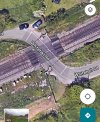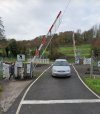I'm not sure if it is still operational as the airfield is closed but a taxiway at Filton Airfield crossed the Henbury loop. Crossing would be operated locally with a slot from Bristol Panel. The barriers rolled horizontally.
I think the level crossing at Filton airfield must be fairly unique. It took aircraft from the runway to the Brabazon hangers. It's out of use now, but still in situ as far as I can see on Google maps. It is a low rolling barrier type. Was there any other level crossing in the UK where they'd be a 747 waiting to cross while a coal train passes by?
It looks like it has sadly been removed completely (at least from what I can see on Google maps) with barely any indication there was ever a crossing
It looks like the barrier on the hanger side is still in situ (long brown coloured object). It must be fairly unique as it is very long and low and rolled into position. I believe it was interlocked with the signalling also. Imagine shutting the gate just after the undercarriage was clear of the barrier and where the rear of the aircraft still was.....
Assuming you all are talking about the aircraft taxiway at the former Filton airfield, the railways name for that crossing was "BAC Crossing".
Officially from a signalling point of view, the railway considered it to be a ground frame (G.F.). The crossing gates were the property of BAC not that of the railway. The signal box (Bristol Panel PSB) would be contacted by the direct line telephone in the building where the control gear was located. This building was also the property of BAC. The G.F. was also inside. The telephone, the G.F. and the associated signalling were the property of the railway. The G.F. was normally operated by airfield staff.
The G.F. when released, allowed a lock mechanism to be unlocked which allowed the gates to move. Once unlocked, the BAC electrical panel (complete with push button switches) would be operated. This powered up the gate motors and the gates then proceeded to open. They were electrically powered by electric motors contained within each gate. And they ran on their own narrow tracks parallel with the railway. Once fully open, the width was wide enough for very large aircraft to cross.
In addition to the lock operated by the G.F., there were also electrical detectors that sensed when the gates were in the closed position. This was owned by the railway and was completely separate to the BAC equipment. If the gates were not detected as being in the closed position, the protecting signals would return to red / be held at red.
There were no conventional level crossing lights. But there was one industrial type red warning light on each side of the crossing that flashed when the gates were moving.
If the gates were being opened for an aircraft to cross, once they were fully open, airfield staff would make sure anyone nearby was told to stay well back. They also checked The taxiway including the railway part for any objects that could potentially be sucked into the aircraft jet engines.
The gates were painted red during the time that I saw them. The brown colour that is referred to, assuming it's the same place is almost certainly rust.
All the BAC crossing equipment was abandoned once the airfield ceased being operational. However, the signalling equipment was still maintained. That was until the signalling controlled by Bristol Panel was decommissioned. By this time a permanent fence had been erected. So the new TVSC signalling did not incorporate the G.F. or any of the other signalling equipment provided for the G.F. and gates.
When I last visited, the crossing surface was still present. It was a strong concrete construction, as it had to carry the full weight of the large aircraft that it had been designed for.
I always felt that allowing this airfield to close was a shame. It had one of the longest runways in the country.
During the times when I was there, I saw America F-111 military aircraft cross over the crossing and saw large jet airliner aircraft cross. I don't remember which types through.


